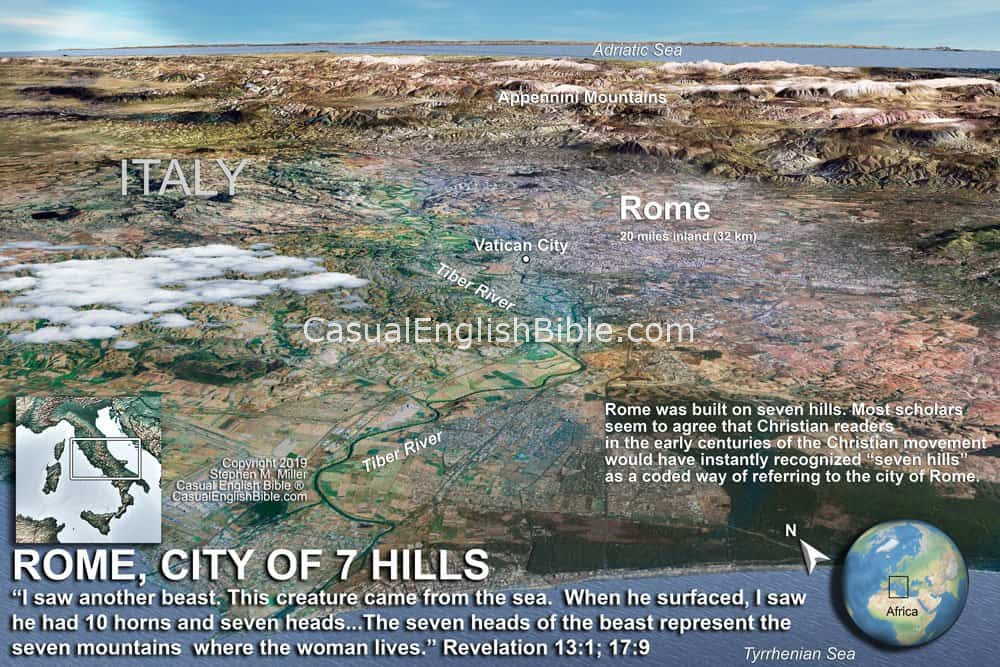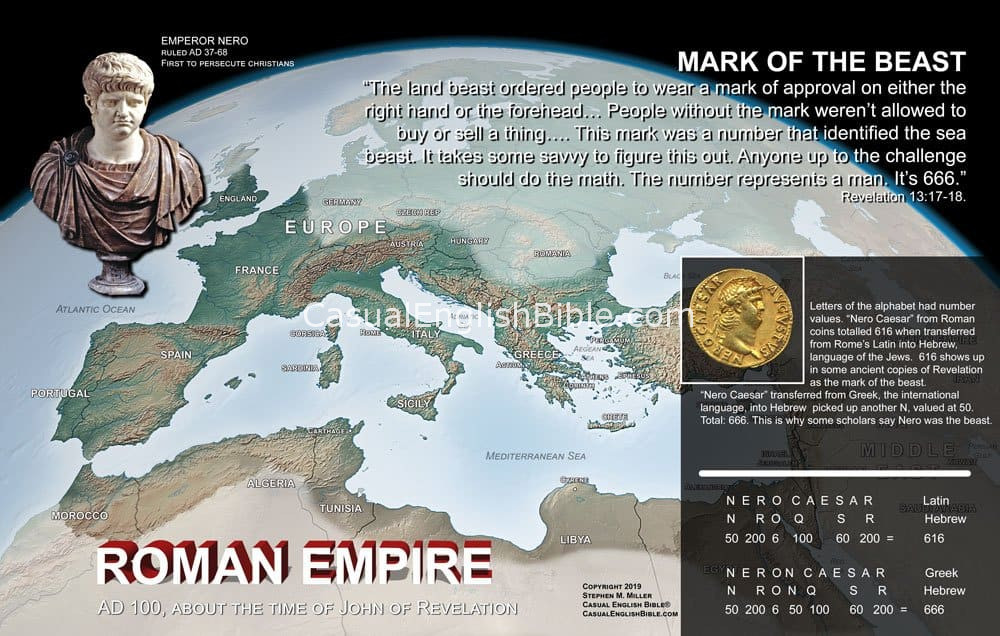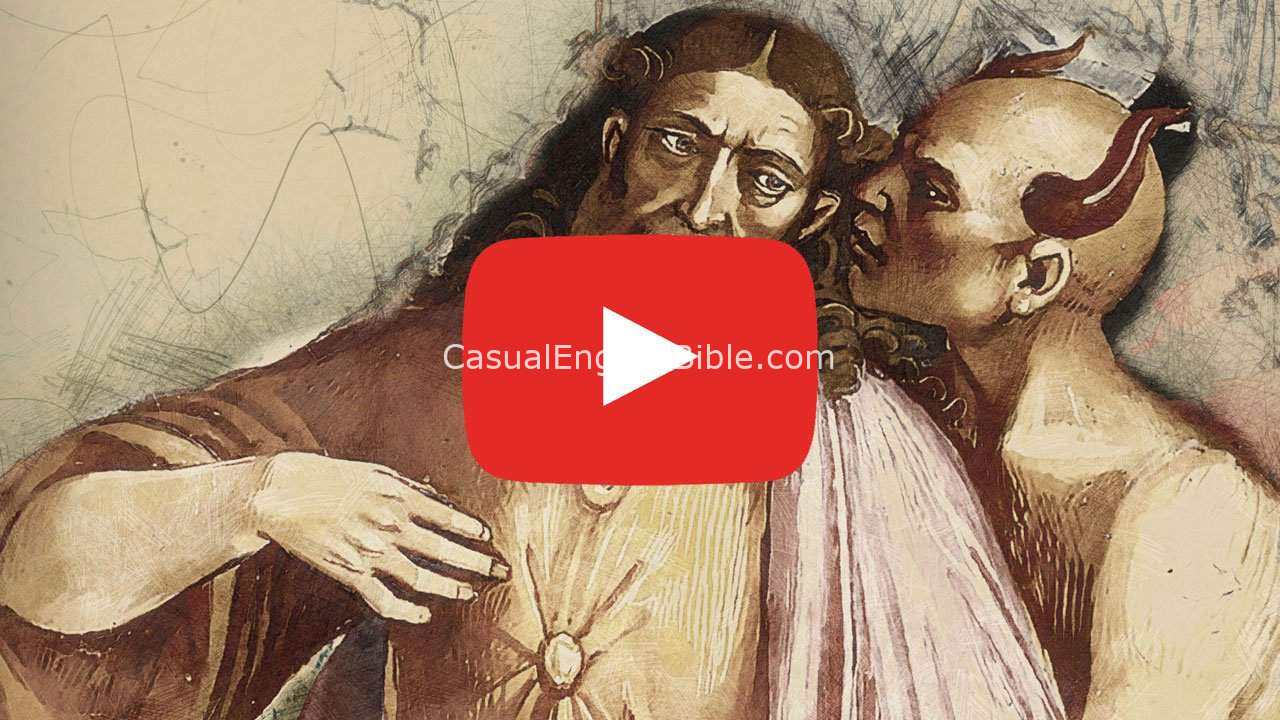Revelation 13
Beasts, underwater and underground
Beast from Sea Conquers World
1I stood on the sand in the sea [1] and I saw another beast. This creature came from the sea. [2] When he surfaced, I saw he had 10 horns and seven heads. [3] A crown sat on top of each horn. [4] Names appeared on each head. Every name insulted God. [5]2This beast looked a bit like a leopard, but with paws like a bear’s and a mouth like a lion’s. The dragon, Satan, [6] backs the beast 100 percent and gives him absolute power to do whatever he wants. 3A sword wounded one head on the beast—fatally, it seemed. Yet, remarkably, the wound healed. [7] People all over the world, astonished by this apparent miraculous healing, instantly became loyal followers of the creature. [8]
4These people worshiped the dragon, Satan. They knew he was the power behind the beast. They worshiped the beast too. They fed him praise, “Isn’t he the greatest? Who would dare go to war against him?” 5The beast had a mouth on him, and he used it to brag himself up and tear God down. [9] He was free to use and abuse his mouth for three and a half years. [10] 6He bad-mouthed God by trashing his name and his heavenly home, along with everyone who lives there with him.
7This beast got the go-ahead to declare war on God’s people. He conquered them and he won the world. He was given full authority [11] to rule over every nation, race, and ethnic group—people everywhere, no matter what language they spoke. 8People all over the world will worship the beast. But their names won’t make it into the Book of Life. [12] This is the Book of the Lamb—the Lamb who, since before the world’s creation, was destined to die. [13] 9If you’ve got ears, you’d better listen to me. 10If you’re destined for prison, you’ll go to prison. If you’re destined to die by the sword, you’ll die by the sword. This calls for endurance. People devoted to God need to stay devoted to him.
Beast from Underground Teams with Sea Beast
11I saw another beast. This creature came from underground. [14] He had two horns like those on a lamb. [15] But he had the voice of a dragon.12He speaks on behalf of the sea beast, with the sea creature’s full authority. The land beast uses his power to compel everyone to worship the sea beast, who had recovered from a lethal wound. 13The land beast did some incredible miracles. He even called fire from the sky, while everyone watched.
14Miracles like that, which the land beast was allowed to perform, tricked people all over the world. He told everyone to build a statue of the sea beast who had survived a sword wound. 15The land beast was allowed to bring the statue to life. It could talk. [16] And it could kill anyone who refused to worship it.
Mark of the Beast, a License to Buy and Sell
16The land beast ordered people to wear a mark of approval on either the right hand or the forehead. Everyone had to do it. The rich, famous, and free. The poor, unknown, and slaves. 17No mark. No sale. People without the mark weren’t allowed to buy or sell a thing. This mark was a number that identified the sea beast.18It takes some savvy to figure this out. Anyone up to the challenge should do the math. The number represents a man. It’s 666. [17]
Footnotes
Some old manuscripts add this first phrase, “I stood on the sand in the sea,” at the end of Revelation 12:17. Some copies say John is the one standing on the sand. Others say it’s the dragon.
Some students of the Bible identify this beast from the sea as the Antichrist. John never uses the word “Antichrist.” The word shows up only briefly in 1 John 2:18, 22; 4:3; and 2 John 1:7. The writer of those short letters said there were already antichrists all over the place. Christians who say there will be an end-time Antichrist pull from Paul, Daniel, Revelation, and other references to create a composite nasty guy. An apocalyptic Frankenstein. Jews of John’s day may have considered the sea this beast rises from as the mysterious abyss. To many of them John’s beast is one that may have associated with the scary Leviathan, a female creature that Jewish legend says God created on day five of creation. It lived in the sea. Its counterpart, the Behemoth, lived on land. Monsters like these could represent invaders, like the Roman Empire, which occupied most of the land surrounding the Mediterranean Sea.
Seven heads represent seven hills (Revelation 17:9). Settlers built the city of Rome around seven hills that in earlier times, according to tradition, had been separate settlements.
“Horns” symbolized military strength, the power to win wars.
These insults were probably the names of Romans, who had been oppressing the Jewish homeland for over a century. Many Bible experts speculate that part of the book of Revelation included a kind of code that let John talk about the oppressive Roman Empire. Because the Romans often traveled by sea, the Jews thought of them as invaders from the sea. Added to that, some Roman emperors said they were gods. People, worshiping what became known as the imperial cult of Rome, sometimes described the emperor by using words that Christians reserved for deity: god, savior, son of god, living god, and divus (a human who became a god).
The dragon is revealed as Satan in Revelation 12:9.
See Revelation 13:14.
It’s a mystery who John meant this creature to represent. Perhaps the most persistent guess is Emperor Nero, who launched the persecution of Christians. He killed himself on June 9, AD 68. That was one day after the Senate fired him. Nero reportedly drove a sword into his throat. Legends soon emerged about Nero’s comeback. The stories declared he hadn’t died, in shades of Elvis. The myth got a boost, possibly, when some of his supporters publicly posted threats—under his byline—vowing to punish his enemies. Roman historians wrote about two Nero imposters who raised armies: an unidentified imposter (AD 69), followed by a Nero lookalike named Terentius Maximus (AD 80s). Both managed to get themselves caught and executed.
This seems to link with something the prophet Daniel reported seeing in a vision several centuries earlier: a leader would “speak against the Most High” but would last for just “a time, times, and half a time” (Daniel 7:25, New American Standard Bible). The strange time given here may simply represent any stretch of time appointed by God. (A bit like “40 days” can mean something like a few weeks or months.) Which isn’t much time, apparently. John expresses this stretch of time with a couple of other phrases, too, including “three and a half years” (Revelation 13:5) and “a time, times, and half a time” (a literal translation of Revelation 12:14).
Some scholars have pointed out that popes have sometimes committed this kind of blasphemy against God. Pope Nicholas (1455) once said, “The Roman Pontiff [the pope] judges all men, but is judged by no one. . . . No one should be surprised that it is in my power to change and do away with laws and to get rid of anything, and even the laws of Christ” (Decretal, de Tranlatic Episcop. Cap., Ferraris’ Ecclesiastical Dictionary). Holy moly.
Some Christians say that this suggests an Antichrist will rule the world for three and a half years. But, again, the time given is probably not meant to be taken literally. Furthermore, John never uses the word “Antichrist.” The word shows up only briefly in 1 John 2:18, 22; 4:3; and 2 John 1:7. The writer of those short letters said there were already antichrists all over the place. Christians who say there will be an end-time Antichrist pull from Paul, Daniel, Revelation, and other references to create a composite nasty guy. An apocalyptic Frankenstein.
The question is who gave him authority to rule the world. The passive phrase in question is literally “was given.” Some scholars say this go-ahead was from the intentional inaction of God. The phrase shows up four times in Revelation 13:5-7, and each time John may have intended readers to presume the “was given” came from God. Another contender might be Satan, recognized by some in this vision as the power behind the beast (Revelation 13:4).
Most Bible experts seem to agree that the Book of Life isn’t a celestial book. It’s a metaphor, a way of identifying people devoted to God. This word picture may have begun centuries earlier, when palace scribes kept records of the king’s enemies and his loyal servants. Kings generally rewarded the loyal souls with life and other perks. People who betrayed the king weren’t so lucky.
It’s hard to know where to put the phrase “since before the world’s creation.” Does it refer to the destiny of the Lamb, as some scholars suggest? Or does it refer to the people whose names were excluded from the Book of Life? That would provide support for the teaching that God selects who will be saved and not saved, a teaching called predestination. Many Christians, if not most, say they believe God allows us to make the choice about our own destiny. There are Bible passages that seem to support each argument. Two examples: (1) God wants to save everyone (2 Peter 3:9). (2) God chose who will be saved (Ephesians 1:4). Still other scholars believe that the land beast represents the emperor himself, beginning with Nero (the first emperor to persecute the Christians), while the sea beast was the Roman Empire. These two beasts together with Satan, they contend, form the Evil Trinity, a counterpoint to the divine Holy Trinity of Father, Son, and Holy Spirit. Daniel 7:3 describes a vision of four beasts coming out of the sea. Like the creature from the sea, they, too, had 10 horns and seven heads.
The beast apparently came from a cave, a hole in the ground, or a bunker—if the description should be taken literally, which might not be a good bet. Also, see the footnote for Revelation 13:1 about Leviathan and Behemoth, mythical monsters on sea and land. It’s unclear who or what this beast represents. One of the most popular guesses is that this dragon-voiced critter represents an end-time false prophet, whom some early Christian writers tagged as the Antichrist. Another popular guess: priests who led Romans in worshiping the emperor.
This land beast has only two horns, compared to 10 on the sea beast. Some scholars say that suggests the land beast doesn’t pack the punch or carry as much authority as the sea beast.
Talking statues was a trick of magicians. A Syrian writer named Lucian, who lived in the AD 100s, wrote about a Greek mystic, Alexander of Abonoteichus, who rigged the image of a snake god with a moving jaw and a hidden speaking tube.
Some call this the mark of the beast. Some ancient copies put the number at 616. Letters had number values. The name of Nero works with both numbers, 616 and 666. He ruled AD 37 to 68 and was the first emperor on record to persecute Christians. His name engraved onto coins in Latin, the official language of the Romans, is “Nero Caesar.” The six letters Jews used to translate that into their language of Hebrew add up to 616. But that same name and title in Greek, the international language of the day, is “Neron Caesar.” Jews used seven letters to translate that version of the name. Those seven letters add up to 666. Another contender is Emperor Domitian (ruled AD 81 to 96), another aggressive persecutor of Christians. His name and title occasionally show up abbreviated on Roman coins with Greek letters that add up to 666.
Discussion Questions
- 1
Most people have heard of the mysterious end-time character known as the beast. But it comes as a surprise to some people that the Bible actually says there are two beasts. One “from the sea” (Revelation 13:1). One from the land, “from underground” (Revelation 13:11). What have you heard taught about the beast or the two beasts?
- 2
Some Bible experts say the beast from the sea represents the Roman Empire, which often invaded countries by sea. Just about anywhere else they wanted to go in the Mediterranean world, they had to go by ship. They won Egypt after a sea battle. Take a look at the footnotes for Revelation 13:1. Would you buy the sales pitch that the beast from the sea might be the Roman Empire?
- 3
The beast from the sea “had 10 horns and seven heads” (Revelation 13:1). John later reveals that the seven heads represent seven hills (Revelation 17:9), though here, the context suggests they may represent seven leaders. That’s because “a sword wounded one head on the beast—fatally, it seemed” (Revelation 13:3). Take a look at the second footnote for that verse. See if you’re convinced this may be a coded way of referring to Nero, the first emperor to launch persecution of the Christians.
- 4
It comes as a surprise to many people that the Antichrist is a no-show in the book of Revelation. Jesus doesn’t mention him, either. How do you react to the idea of an end-time Antichrist after reading everything the Bible has to say about him by name, antichristos, in Greek, the language of the New Testament? Here is every Bible verse that mentions him.
- “You’ve heard an antichrist is coming. Look around. They’re already here, crawling all over the place. . . . Anyone who says Jesus isn’t the Messiah is a liar. There’s your antichrist. It’s anyone who turns their back on the Father and the Son” (1 John 2:18, 22).
- “People who don’t believe in Jesus aren’t speaking for God. They don’t have God’s Spirit. They have a spirit that’s antichrist. You’ve heard an antichrist is coming. Well, that spirit is already here” (1 John 4:3).
- “Liars have fanned out and covered the world. They’re anti-Jesus Christ. They won’t admit he came in the flesh as a human being. Anyone who tells lies like that is the antichrist” (2 John 1:7).
- 5
The beast from underground is the one usually associated with the mark of the beast and sometimes with the Antichrist, a character not mentioned in Revelation. When we read about this beast from Revelation 13:11-18, what clues do we get to point us in the direction of trying to identify him?
- 6
Some Christians say they believe that the mark of the beast is a literal mark on a person’s forehead or arm. And they say it’s used as currency and as a way of identifying the people who worship the beast, as Revelation says. Some have speculated that it might be a 666-model chip embedded and manipulated through some kind of the world banking system. That’s why some people resist the idea of an earth-wide currency—a currency that international travelers might love. Take a look at the footnote for Revelation 13:18 and see what you think about the theory that suggests the mark of the beast is the name and title “Nero Caesar.”
- 7
LIFE APPLICATION. This chapter in Revelation has generated some of the wildest theories about end times. Can you think of any you’ve heard? And what kind of damage does it do to Christianity when speculation is passed off as fact?









